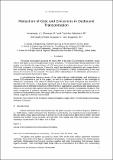Reduction of Costs and Emissions in Outbound Transport
Author(s)
Amazonas Machado, Leonardo; Chavelas Manzo, Ricardo; Silva Tourinho Nakamura, Rodrigo
DownloadCapstone project (394.7Kb)
Terms of use
Metadata
Show full item recordAbstract
The global food system accounts for nearly 30% of the total CO2 emissions worldwide. About 19% of that figure is due to transportation-related emissions. The main problem being addressed in this project is to identify the main drivers of CO2 emissions in outbound transportation for a major CPG food company in Antioquia, Colombia, which has declared sustainability as a major driver in their corporate strategy. By indirectly measuring CO2 emissions, a better understanding of the main drivers of emissions can be acquired. The cause-effect relationships on the distribution performance in emissions and cost to serve are in place.
A comprehensive literature review of the state-of-the-art methodologies and techniques to assess CO2 emissions is part of this project, as well as a qualitative evaluation of the challenges of Antioquia’s topography. Two different methodologies have been used throughout this document to estimate CO2 emissions. A fuel-based approach and a distance-weight-based approach use CO2 equivalent units to estimate emissions at different levels of aggregation. Quantitative and spatial analysis allows us to conclude that regions that are harder to reach (low-volume municipalities located in hilly areas, irrespective of distance traveled) have a higher cost to serve and higher emissions due to an increase in transportation costs, fuel usage, difficulties to consolidate cargo and difficulties to increase vehicle usage due to the low volume sales.
Date issued
2025-04-02Keywords
Food market, CO2 emissions, Outbound logistics
Collections
The following license files are associated with this item: